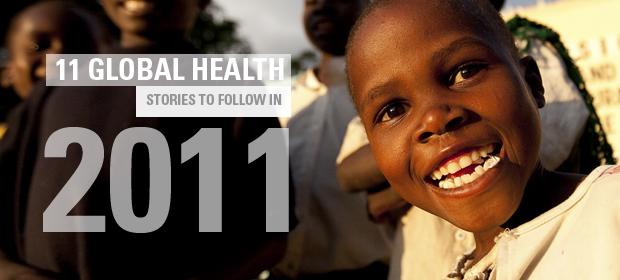Where We Work
See our interactive map


As we reflect back on the global health stories that made the news in 2010—and some that didn’t—here are 11 top stories we will be following in 2011.
In 2010, we celebrated the World Health Organization’s release of the WHO Global Code of Practice on the International Recruitment of Health Personnel and global recommendations for the retention of health workers. The code, adopted in May 2010, highlights the critical issue of human resources for health. This new code (only the second code adopted in WHO’s history) is an ethical framework that guides member states in the recruitment of health workers, specifically discouraging active recruitment of health workers from developing countries that face the most critical health workers shortages. The code also encourages “destination” countries to collaborate with “source” countries to support and sustain human resources for health development and training.
In 2011, we hope to see the rapid rollout of the code, and to see the US Government’s Global Health Initiative fully develop and implement a strategy for human resources for health. As IntraHealth’s Maurice Middleberg proposes in Saving Lives, Ensuring a Legacy: A Health Workforce Strategy for the Global Health Initiative, “the GHI should promote evidence-based approaches to increasing retention and productivity,” because “incentives that keep workers are also those that foster high productivity—retention and productivity are in many ways two sides of the same coin.”
Another seemingly underreported story in 2010 was the UN’s declaration, in August 2010, of the International Year of Youth, 2010-2011.The UN declared that the year would be devoted to encouraging more investments in youth, and that this would be accomplished, in great part, by listening to the youth themselves. More investment is needed in innovative strategies to reach youth, especially girls, through adolescent reproductive health education and services—and health information in general. Many countries in which IntraHealth works have a few successful pilot programs, but “adolescent reproductive health” is often buried somewhere in the ministry of health, or youth, or both, and few have a well developed, scaled up, national program.
Girls and boys are looking for information and services—and not finding them easily. In many countries, more than half of young people are sexually active.[1] But condom use is low. And access to other modern contraception is extremely limited by lack of knowledge and lack of access to youth-friendly health workers and health facilities. At least one-fourth of the estimated 20 million unsafe abortions per year are performed on women aged 15 to 19.[2] Teenage pregnancies in the US rose in 2006 for the first time in a decade.[3]
“Contrary to the perception of many parents and community leaders, adolescents engage in sexual activity, and they suffer grave consequences in societies that deny this reality and fail to prepare them adequately for sexual experience,” as noted in Removing barriers to adolescents’ access to contraceptive information and services.
Adolescent girls need more information on reproductive health, but also protection against gender-based violence; one in three women will experience some form of sexual violence in her lifetime. The efforts of partnership such as Together for Girls and the Girl Effect are laudable, as is the Global Health Initiative’s focus on women and girls.
We hope that 2011 will really be the year of the youth, both girls and boys—and that we will see increased attention to, and resources dedicated toward, the health of adolescents.
Page 1 | 2 | 3 | 4 | all on one page
[1] According to national Demographic and Health Surveys
[2] According to the World Bank’s Reproductive Health Action Plan 2010-2015
[3] According to the Guttmacher Institute’s study published in 2010, U.S. Teenage Pregnancies, Births and Abortions: National and State Trends and Trends by Race and Ethnicity.)



